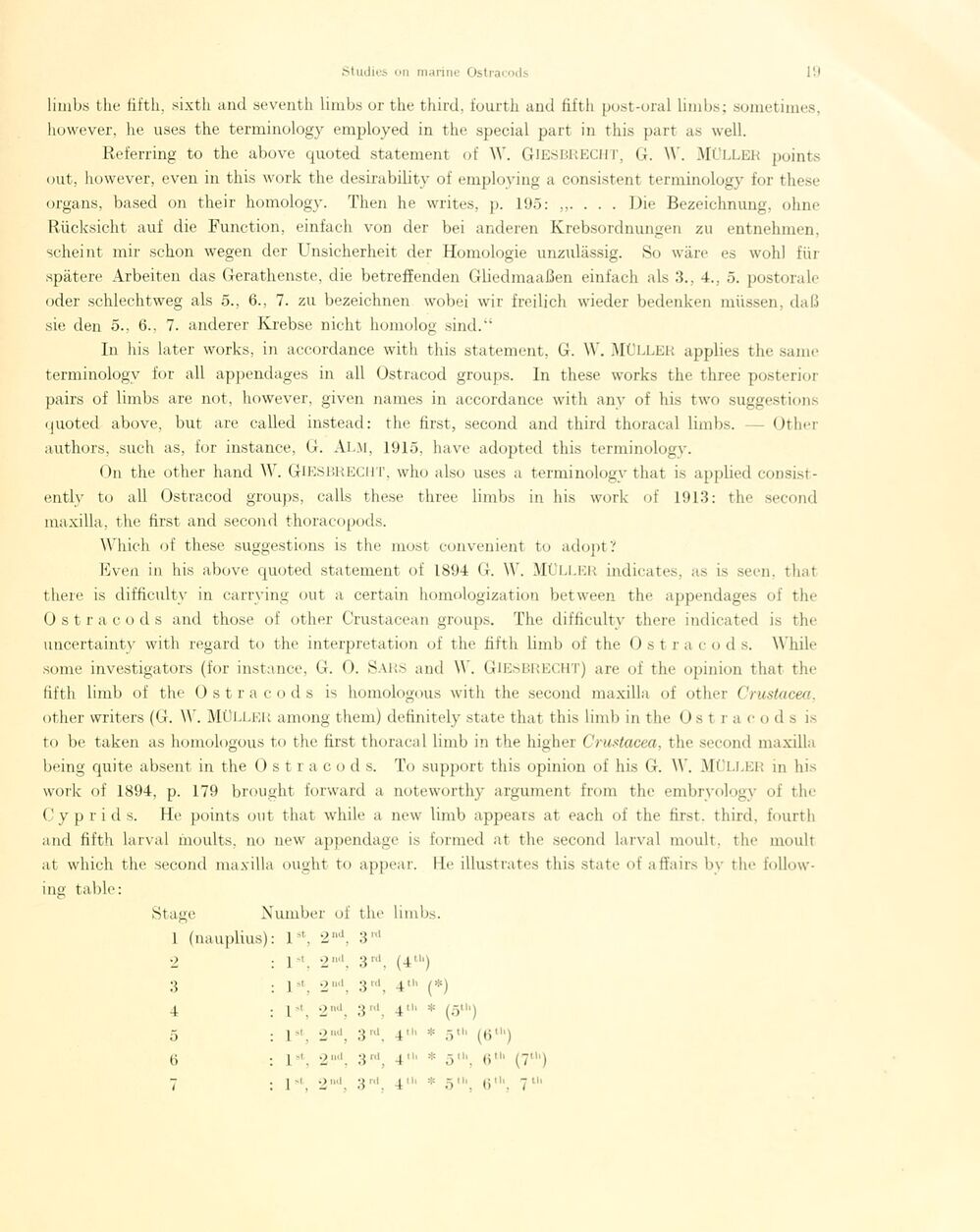
Full resolution (JPEG) - On this page / på denna sida - Sidor ...

<< prev. page << föreg. sida << >> nästa sida >> next page >>
Below is the raw OCR text
from the above scanned image.
Do you see an error? Proofread the page now!
Här nedan syns maskintolkade texten från faksimilbilden ovan.
Ser du något fel? Korrekturläs sidan nu!
This page has never been proofread. / Denna sida har aldrig korrekturlästs.
limbs the fifth, sixth and seventh limbs or the third, fourtb and fift li post-oral linihs ; sometimes,
however, he uses the terminology employed in the special part in this part as well.
Referring to the above quoted statement of W. GlESBRECHT, G. \Y. MÜLLER points
out, however, even in this work the desirability of emploving a consistent terminology for these
organs, based on their homology. Then he writes, p. 195: Die Bezeichnung, ohne
Rücksicht auf die Function, einfach von der bei anderen Krebsordnungen zu entnehmen,
scheint mir schon wegen der Unsicherheit der Homologie unzulässig. So wäre es wohl für
spätere Arbeiten das Gerathenste, die betreffenden Gliedmaaßen einfach als 3., 4., 5. postorale
oder schlechtweg als 5., 6., 7. zu bezeichnen wobei wir freilich wieder bedenken müssen, daß
sie den 5., 6., 7. anderer Krebse nicht homolog sind.“
In his later works, in accordance with this statement, G. \Y. MÜLLER applies the same
terminology for all appendages in all Ostracod groups. In these works the three posterior
pairs of limbs are not, however, given naines in accordance with any of his two suggestions
quoted above, but are called instead: the first, second and third thoracal limbs. — Other
authors, such as, for instance, G. Alm, 1915, have adopted this terminology.
On the other hand W. GlESBRECHT, who also uses a terminology that is applied
consist-ently to all Ostracod groups, calls these three limbs in his work of 1913: the second
maxilla, the first and second thoracopods.
Which of these suggestions is the most convenient to adopt?
Even in his above quoted statement of 1894 G. AY. MÜLLER indicates, as is seen, that
there is difficulty in carrying out a certain homologization between the appendages of the
Ostr a c o d s and those of other Crustacean groups. The difficulty there indicated is the
uncertainty with regard to the interpretation of the fifth limb of the Ostr a c o d s. While
some investigators (for instance, G. O. Sars and W. GlESBRECHT) are of the opinion that the
fifth limb of the Ostracods is homologous with the second maxilla of other Crustacea,
other writers (G. W . Müller among them) definitely state that this limb in the Ostrac o d s is
to be taken as homologous to the first thoracal limb in the higher Crustacea, the second maxilla
being quite absent in the Ostracod s. To support this opinion of his G. W. MÜLLER in his
work of 1894, p. 179 brought forward a noteworthy argument from the embryology of the
C y p r i d s. He points ont that while a new limb appears at each of the first, third, fourth
and fifth larval moults, no new appendage is formed at the second larval moult, the moult
at which the second maxilla ought to appear. I le illustrâtes this state of affairs by the
follow-ing table:
Stage Number of the limbs.
1 (nauplius): lst, 9 ntl 3 r<*
o lst, 9 n<l 3r<1, (411 )
3 : 1at, 9 ud “ 5 31,1, 4111 (*)
4 : l9t> 9 ntl 3 41,1 * (5th)
5 : ls’, 9 ml w 5 3ri* 4 * 5 (b111)
t> ls\ 9 ntl 3 ni, 4 U. * X tll gtll
i ! D’, 9 ml •) ni 1 li * X t II 01 II
<< prev. page << föreg. sida << >> nästa sida >> next page >>